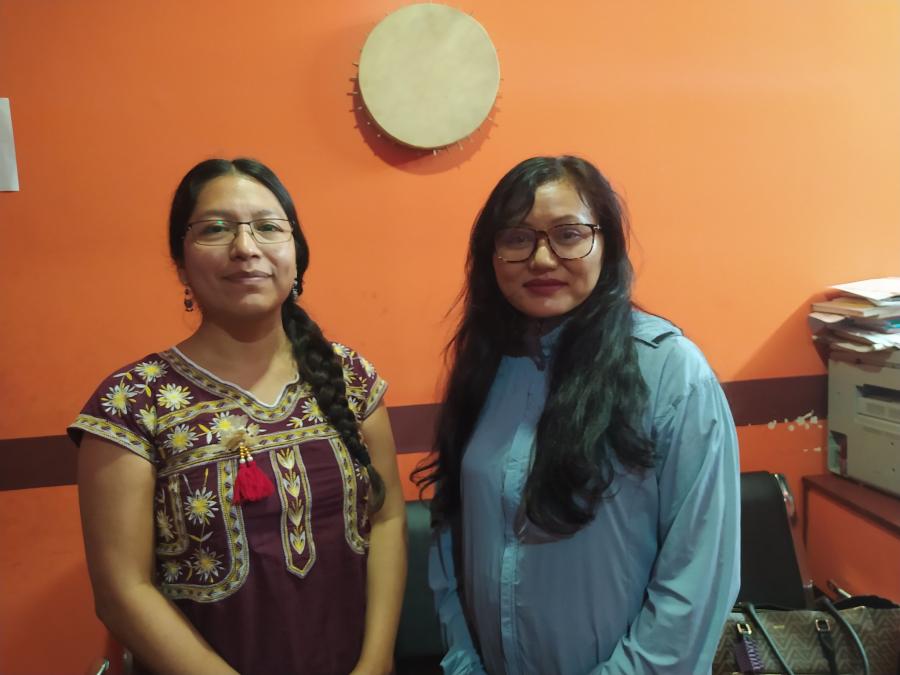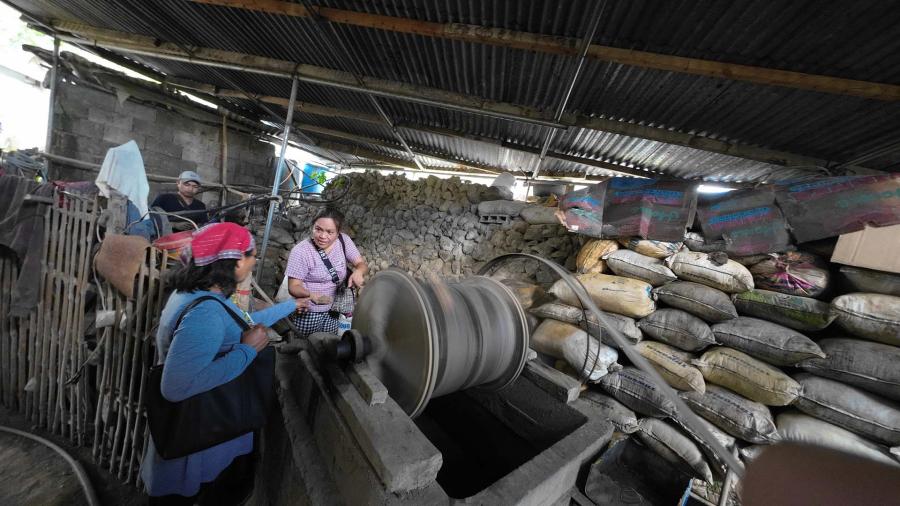Arya Tara School opened in Kathmandu, Nepal, in winter 2000 with the profound vision of assisting young Tibetan Buddhist nuns to get a full secular and Buddhist education to enable them to fulfill their potential and act on their vows of compassion in practical ways.
The 18 student nuns now enrolled at Arya Tara come primarily from poor villages in Nepal, with a few from Tibet and India, and range in age from nine to 22. With the free education they receive from this unique year-round boarding school, they are expected to become teachers, health care workers, and community leaders who assist in the development of their villages and the surrounding areas with the genuine benefit of the people at heart.
The Arya Tara project and its supporting organization, the Nuns Welfare Foundation of Nepal, are breaking new ground in providing full education for Buddhist nuns and establishing projects of engaged Buddhism in Nepal. Arya Tara and the Nuns Welfare Foundation’s approach to practical compassion should have a significant impact not only on important areas of people-centered development (such as leadership development, health care, and education), but also on gender equality, and preservation and revival of Tibetan Buddhist culture. It also helps maintain a mutually beneficial connection between Buddhists in the Himlayas and supporters of Buddhist culture throughout the world.
The young students of Arya Tara tell people their villages need a teacher, a doctor, good water, a road, money, a gompa (monastery). They come from areas that have no schools or poor schools and few or no health facilities. These communities also need basic sanitation; income generation; resolution of gender, caste, and ethnic inequalities; and leaders to maintain their spiritual traditions.
Nepal’s per capita annual income is $240; 90 percent of Nepali families are subsistence farmers. The literacy rate for women in Nepal is only 25 percent—half that for men. As minorities in the officially Hindu kingdom of Nepal, people of Tibetan descent are underrepresented in government, business, and education. Because they are not Hindu, they are usually considered low caste by the 85 percent Hindu majority, including by those people in positions of authority.
Tibetans have lived in Nepal for centuries. From ancient times, Tibetan traders regularly crossed the mountains to reach, and sometimes settle near, the central markets of Kathmandu. Tibetans have also traditionally made pilgrimages to Nepal, especially to the sacred stupas (structures representing the mind of Buddha) of Swayambu and Boudha. In the 1700s and 1800s, the Nepali government encouraged immigration and offered citizenship to many thousands of Tibetans who then settled in Nepal. These waves of immigrants (from different parts of Tibet, all with slightly different customs) developed as specific ethnic minorities. Probably best known to westerners are the Sherpa people from eastern Tibet who remain concentrated in the mountains near the Tibetan border. Since 1959, about 15,000 Tibetan refugees fleeing Chinese rule and restrictions on Buddhist practice also settled in Nepal. This wave of immigration has helped spark a revival of interest in traditional Tibetan Buddhist customs and involvement in monastic institutions.
Women’s roles have traditionally been strictly defined in Nepal and Tibet. In Buddhist cultures, the respectable paths for women have been to get married or to become a nun. Most Tibetan Buddhist nuns, especially those from remote areas, come to Buddhist practice with little or no formal education. When they join a monastery, they receive religious training and learn to recite Buddhist texts, yet many cannot even write their own names properly. Although most monks receive a formal secular education and many become Tibetan doctors, dharma teachers, social workers, and even directors of dharma centers and colleges, Buddhist nuns rarely do any of these things.
Nuns have vowed to use their innate wisdom of love and compassion for other beings. They are greatly respected in Buddhist communities and are accepted role models for other women and girls. Many Buddhist nuns wish to engage in bodhisattva activity—helping others—but usually lack the skills and opportunities to do so. For more than three years, the young nuns of Arya Tara School have been steadily growing in their understanding of Buddha dharma, their realization of their own compassionate nature, their fluency in English, their knowledge of the world, and their capabilities. If nuns are educated and become teachers, midwives, doctors, and so on, communities are likely to accept their assistance and leadership; families, inspired by this example, are more likely to allow their daughters to finish school and take on more responsibilities for the community.
In addition to studying Tibetan, English, dharma, math, and science, each nun at Arya Tara School takes on responsibilities for the school (such as helping with shopping or laundry), and each older nun serves as mentor for a younger nun. The academic assignments are different from standard schools; for example, the advanced English class recently wrote an essay on the meaning of compassion and reported on articles from Western Buddhist magazines. The beginning-level class answered questions about life in their villages and people’s needs.
The student nuns are genuinely committed to the goals of the school, and they reflect its initial success. When asked what they want to do when they get older, they say “I want to help poor people,” “I want to be a doctor,” “I want to start a nunnery,” “I want to be a teacher,” and so on.
“Now I really understand the dharma, I don’t just say the prayers,” said a nun who previously stayed at a nunnery in Dharamsala, India. When asked what they like about their teacher, one nun responded, “[My teacher] says it’s not only important for us to understand dharma, we must also understand the community and the world and learn to practice compassion every day,” said another nun.
Tsundru, a senior nun, said her perspectives on gender have changed. “Because of Ani Choying [the school’s founder] and the other women I have met, I have realized that women can do as much as men,” she said. Many visitors are moved by the sense of joy, thoughtfulness, and welcome they encounter at the school.
Naturally, the Arya Tara School was started by a Buddhist nun. Ani Choying Drolma was born to a Tibetan refugee family in Kathmandu in 1971. At age 10, she became a Buddhist nun and at age 13 joined Nagi Gompa, a Tibetan Buddhist nunnery perched in the hills encircling Kathmandu. The abbott of Nagi Gompa, Tulku Urgyen Rinpoche, was a highly respected Buddhist master and became Ani Choying’s principle teacher and mentor. He believed that all human beings are equally capable of awakening to their enlightened nature. Inspired by the Rinpoche’s teachings and altruistic example of putting others’ needs before his own, Ani Choying also became aware of the problems of those around her whom she had vowed to serve. She realized that many of her fellow nuns shared her desire to help local people, but did not have the training to do so. She had a vision: Why not establish a school for nuns to receive formal and practical education?
Tulku Urgyen Rinpoche imparted to Ani Choying another great gift: instruction in the art of beautiful melodic traditional Buddhist chant. In 1996 Ani Choying began to record this music and discovered that there was a great interest in it among people in the United States, Europe, and Singapore. This interest quickly generated major sales of Ani Choying’s compact discs and a series of concert tours around the world. At the concerts, Ani Choying tells westerners and other Asians about Tibetan Buddhism, the situation in which Buddhist nuns and the people of the Himalayas live, and the Arya Tara School. In turn, many foreigners have provided major contributions of technical, volunteer, and financial assistance, as well as immense enthusiasm and moral support. The majority of teachers at the Arya Tara School have been U.S. and European volunteers who stay for three months to teach English, math, and science. They leave the school with a depth of understanding of Buddhist culture and a sense that they have contributed significantly to the future of these girls and the Himalayan region. Although Arya Tara School is thus far a small project, it is significant in that it uses foreign support to promote indigenous leadership using the model of monastic Buddhism and its teachings of compassion and caring for others.
Ani Choying has many plans for Arya Tara School. Construction is underway on a new school building in Pharping, a peaceful Buddhist community on the outskirts of the Kathmandu Valley. Once the school moves into the new location, students will have more contact with other Buddhist teachers, have a more quiet and healthy learning environment (the city of Kathmandu has among the worst air pollution problems in Asia), and be closer to rural communities similar to those they will one day serve. The new school will eventually have the capactiy to house up to 100 students and complementary staff, as well as sufficient classrooms, an extensive library, quarters for visiting dharma teachers, and a prayer hall. Although much learning has taken place using a minimum of paid teachers, the academic program at Arya Tara must be enhanced to ensure students’ ability to enter and succeed in post-secondary education. This year the Nuns Welfare Foundation plans to hire a principal to develop a stronger curriculum and teaching programs and will continue to add permanent staff as needed. Nuns Welfare Foundation plans to fund scholarships for this continued education and provide seed money for the nuns to begin their own projects of compassionate action when they finish their schooling at Arya Tara.
Ani Choying’s dream of Arya Tara School has become reality and the promise of Arya Tara is on its way to being fulfilled.
Ani Choying Drolma is the founder of Nuns Welfare Foundation and the Arya Tara School. Susal Stebbins is the coordinator of the Nuns Welfare Foundation.


